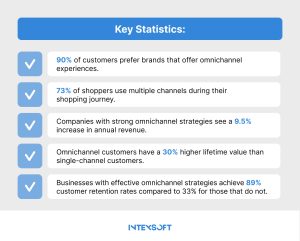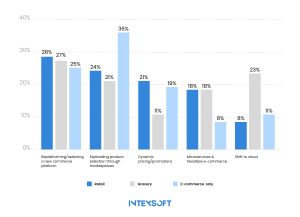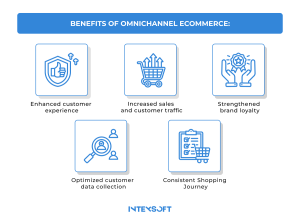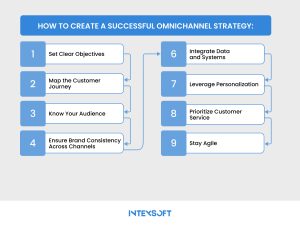
Read this article to determine the most suitable ecommerce omnichannel strategy for your business. You’ll learn essential statistics, benefits and challenges, and discover popular platforms to use. Explore top strategies, and if you need more information or further guidance, contact us for a free consultation with our ecommerce experts.
Reading time: 17 min.
The global retail market, despite the lingering shadows of Covid-19, is on a steady upward trajectory. Projections indicate it will exceed $37 trillion by 2027.
Retail companies, however, aren’t immune to the challenges—rising inflation, shifting customer demands. These are obstacles that can’t be entirely sidestepped. But the impact can be mitigated. AI has been hailed by many as the magic bullet, a catch-all solution for these hurdles. Yet, it’s far from the only option on the table.
There are other technological solutions that online store owners should consider—especially given that 70% of millennials engage with brands across an average of six channels. That’s not a statistic to ignore.
In this analysis by IntexSoft, we break down the essentials of omnichannel eCommerce and how you can benefit from it.

As you can see from the information above, customers overwhelmingly choose brands with omnichannel experiences, with 90% preferring them.
By adopting an omnichannel approach—integrating physical stores, e-commerce sites, mobile apps, and other customer touchpoints—you can craft a consistent shopping experience. The data is clear: omnichannel customers shop nearly twice as often as those who stick to a single channel. They spend more, too. The implication? A well-executed omnichannel strategy is a path to increased profit.
We must acknowledge that challenges continue to arise, making the path more complex than before. Below, we highlight several key points through the statistics provided. However, for more details about these typical challenges, you can find further insights in the middle of our article.

| Parameter | Omnichannel ecommerce | Multichannel ecommerce |
| Definition | Integrates all channels for a unified shopping experience | Uses multiple channels independently for customer shopping |
| Customer experience | Provides a unified, consistent experience across all channels | Experience may differ across various channels |
| Goal | Enhance customer satisfaction and brand loyalty | Expand reach and accessibility by offering products on multiple channels |
| Inventory management | Centralized, real-time inventory across all channels | Managed separately for each channel |
| Marketing strategy | Unified, consistent across all channels | Varies by channel |
| Customer support | Integrated, providing the same level of service across all touchpoints | May vary depending on the channel |
| Technology infrastructure | Requires robust, interconnected systems | Less complex, often separate systems for each channel |
| Brand messaging | Consistent, regardless of the channel | Can become diluted or inconsistent across channels |
| Customer data | Unified view of customer data, enhancing personalization and insights | Data is siloed, limiting cross-channel insights |
It’s about forging a seamless experience for every client, where each channel—from the brick-and-mortar store to the mobile app—works in concert. This strategy demands perfect coordination, including centralized inventory control, a unified marketing vision, and a tech infrastructure that binds it all. The payoff? A consistent brand message and client experience that stands firm, regardless of where or how the interaction unfolds.
On the other hand, this type is about accessibility. It’s the more traditional approach, where businesses operate across various channels, but each channel functions independently. While this expands the reach, it often leads to a disjointed experience for the customer. Inventory is managed separately, marketing strategies vary by channel, and customer support may differ depending on where the interaction takes place. The brand message can become diluted, and the customer’s journey might feel fragmented.

This is the first benefit that is completely obvious. Every interaction—whether on a mobile app, Instagram, or in-store—is flawlessly connected, so this approach positively impacts customer experience. Now, that’s the valuable advantage the omnichannel model always offers. It keeps your cart, payment info, and order history perfectly synced, making your shopping journey smooth and hassle-free.
More excellent sales and traffic are the second benefit and the end goal for any online store owner. Let’s explain concisely. A typical customer may try on a product in-store, later add it to their online cart, and finalize the purchase from home.
Many research studies underscore the impact of this approach. Assess the following: omnichannel shoppers spend more—4% more in-store and 10% more online—than those using only one channel. Additionally, integrating marketing strategies across various platforms enables online stores to engage customers throughout their buying journey, further boosting sales.
The ease and consistency of the omnichannel experience foster a deeper connection between customers and brands. Personalized interactions across all channels not only build trust but also encourage repeat engagements. Customers who experience a unified brand presence are more likely to return and recommend the brand to others, enhancing overall loyalty and lifetime value.
An omnichannel strategy provides a comprehensive view of customer interactions, yielding valuable insights into preferences and behaviors. Nearly 90% of consumers value two-way communication with brands, and the ability to collect and analyze data from these interactions helps businesses tailor their marketing efforts and product offerings more effectively. This strategic use of data drives smarter decision-making and refined customer engagement.
A shopper might start by browsing on Instagram, then move to the ecommerce website, and finally subscribe to emails—all without missing a beat. This consistent experience helps businesses maintain a continuous dialogue with all clients, offering them personalized recommendations and promotions that keep them engaged. This is, first of all, about loyalty.
The path to achieving better experience for the customer is fraught with complexities that require a deep dive into the underlying issues.
The expectation is simple: customers want uniformity in their experience, whether they’re reaching out via email, on social media, or walking into a physical store. But the reality is far more complex. Imagine a customer who stumbles upon a product online, asks a few questions through Instagram, and ultimately decides to purchase it in-store. If there’s a breakdown in communication between these touchpoints, you’ve got a problem. Some platforms are stepping in to bridge these gaps. But make no mistake—this is a challenge that demands constant vigilance.
Consider the scenario where a product appears available online, but in truth, it’s out of stock due to lagging updates in inventory data. It’s a recipe for customer dissatisfaction and lost sales. The solution lies in total visibility—having a real-time, cross-channel view of inventory. It sounds straightforward, but the implementation is anything but.
The convenience of omnichannel comes at a cost, particularly when it comes to order fulfillment. A customer might order online and pick up in-store or decide to return an online purchase at a physical location. Without a system that unifies these processes, chaos is inevitable.
Some businesses consider omnichannel as a technological challenge. First of all, this has become a reality due to significant investment in infrastructure. Omnichannel ecommerce demands it. However, only some companies are ready to invest. Technology integration has to be on the front page.
In an omnichannel world, understanding where your sales are coming from is increasingly difficult. Customers today interact with multiple touchpoints—social media, online research, and in-person visits—before making a purchase. Accurately attributing sales to the right channels is not just a matter of bookkeeping; it’s essential for refining your marketing strategy. QR codes and unique landing pages are tools in this fight, but the battle is ongoing.
Logistics in an omnichannel environment are a beast of their own. Orders need to be fulfilled quickly and accurately, whether they’re placed online, in-store, or through an app. This requires managing multiple shipping options, ensuring accurate tracking, and coordinating with carriers. The stakes are high—missteps here lead to delays, errors, and a direct hit to customer satisfaction.
IntexSoft highlights this as the final challenge worth serious consideration. The stakes are high when it comes to managing vast amounts of sensitive data. Mishandling this could have far-reaching consequences for your customers—consequences that grow even more severe as your business scales. The responsibility falls squarely on your shoulders to oversee these information processes and protect privacy. We recommend preparing for this quite early on. Personal and payment data must be handled with the utmost care. A solid data management system isn’t merely a recommendation—it’s a necessity.
To capitalize on the advantages and steer clear of costly missteps, IntexSoft is prepared to guide you with a concise plan. By following deliberate steps, you, as a store owner, can develop a solid understanding of the critical factors that demand your attention in the long haul.

This is the first step to guarantee a solid foundation for making informed choices in omnichannel eCommerce solutions. Whether your focus is on boosting online sales, driving more foot traffic to physical stores, enhancing customer retention, or increasing brand loyalty, these goals will shape your strategy. Clear objectives ensure that your efforts are purposeful and yield the results you are aiming for.
Identify key stages:
Each stage represents a juncture where customers engage with your brand through social media, website, mobile app, or post-purchase email follow-ups. Look at these corners individually and discern areas for enhancement.
Get to know the demographics, preferences, and behaviors of your primary customer segments to engage them. Focus your efforts on the channels clients use most, whether that’s mobile messaging through WhatsApp or social media browsing. Meeting customers where they are ensures higher engagement and brand affinity.
Consistency in brand identity is vital across all platforms. From your website to social media and physical stores, your messaging, tone, and visual elements should create a unified experience. A strong, cohesive brand presence not only builds trust but also fosters customer loyalty, making your brand easily recognizable across all channels.
For a truly effective omnichannel strategy, integrating your backend systems is an important step that every C-level executive must prioritize. Inventory management, CRM, and order processing systems need to be very well-synchronized to ensure a seamless flow of real-time data across all channels. Naturally, there are additional tools that can enhance your organization and control at this stage, with Shopify being a key example.
IntexSoft has a team of seasoned experts skilled in tracking multi-channel attribution. They consistently provide valuable insights into which marketing tactics are generating conversions and which are not.
The absence of personalization spells the downfall of any online store, leading to lost customers and stagnant conversion rates. The power lies in the data—harness it to tailor every product recommendation, promotion, and piece of content across all channels. By tracking user behavior on your website, you can craft a shopping experience that feels personal, showcasing the products that speak directly to returning customers, nudging them towards that next purchase.
For any omnichannel strategy to thrive, customer service is important. Your team must be ready to assist customers across every touchpoint. Offer clients a seamless experience through live chat, email, or in-store service. In this regard, IntexSoft advises employing AI-driven chatbots. They are valuable helpers that work around the clock, taking a significant portion of communication off your shoulders. Keep your service standards consistently high.
If you forget about agility and are not always ready to change certain points, adjust, and even readjust to new factors, this will create a significant problem. Stay agile, as ecommerce is evolving at an incredible pace. To keep your operation afloat, you need to regularly assess your omnichannel performance and create some wiggle room for industry trends as needed.
Look at the table below for details and assess which omni channel ecommerce platform is most suitable for your needs.
| Platform | Overview | Key Features | Best For |
| Shopify | A platform that balances ease of use with scalability. | – Multi-Channel Integration – Advanced Analytics – POS System |
Small to medium-sized businesses seeking a straightforward, scalable solution with strong support. |
| Magento | A flexible platform ideal for businesses with complex needs, offering extensive customization. | – Customizable with extensions and themes – Advanced Reporting – Global Reach (languages, currencies) |
Medium to large businesses needing extensive customization and complex eCommerce features. |
| Salesforce Commerce Cloud | A solution for enterprises with deep CRM integration and advanced AI capabilities. | – Unified Customer View with Salesforce CRM – AI-Powered Insights – Global Scalability |
Large enterprises requiring CRM integration and AI-driven features. |
| BigCommerce | Known for its flexibility and ease of integration, with a set of built-in tools. | – Built-In Features (SEO, marketing, analytics) – Multi-Channel Selling (Amazon, eBay, social media) – Flexible APIs |
Growing businesses needing scalability with built-in features and strong integration capabilities. |
| WooCommerce | A WordPress plugin transforming a WordPress site into an eCommerce store, offering affordability and flexibility. | – WordPress Integration – Customizable with extensions – Cost-Effective |
Small to medium-sized businesses prefer a WordPress-based solution with flexibility and affordability. |
Now that you have a comprehensive understanding of omnichannel software solutions, including both their benefits and potential challenges, you may have questions or need information tailored to your company’s specific needs.
This is where IntexSoft can help. Contact our experts at any time for a free consultation.